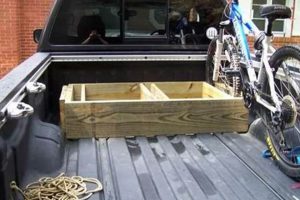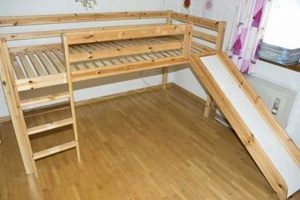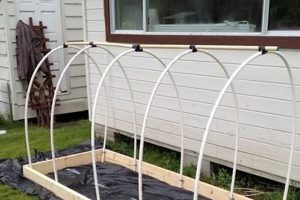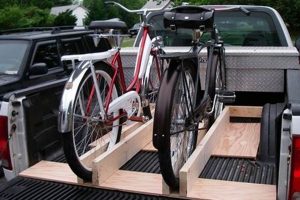A self-constructed structure designed to create a level sleeping surface within the cargo area of a pickup truck. This typically involves building a frame and decking to elevate a sleeping space above the wheel wells, maximizing usable area. An example might involve using plywood and lumber to build a platform tailored to the specific dimensions of a truck bed, allowing for storage underneath.
The creation of an elevated sleeping area in a truck bed provides a practical solution for travelers, campers, and outdoor enthusiasts seeking a mobile and economical accommodation option. Historically, such modifications have enabled individuals to adapt their vehicles for dual purposes, transforming them into temporary living spaces while retaining their primary function. The benefits include cost savings compared to traditional lodging, increased flexibility in travel, and enhanced convenience for accessing remote locations.
This introduction provides context for a more detailed examination of design considerations, material selection, construction techniques, and safety precautions associated with building such a structure. The following sections will address these topics comprehensively, providing the necessary information for successful implementation.
Construction and Utilization Tips
The following guidelines aim to optimize the design, construction, and usage of a self-made truck bed sleeping solution. Adherence to these recommendations will contribute to structural integrity, user safety, and overall satisfaction.
Tip 1: Precise Measurement: Accurate dimensional data of the truck bed is paramount. Account for wheel well intrusions and any existing bed liners. Use these measurements to create a detailed plan before cutting any materials.
Tip 2: Material Selection: Opt for construction-grade plywood or dimensional lumber suitable for load-bearing applications. Consider the weight capacity of the truck bed and select materials accordingly. Marine-grade plywood offers enhanced moisture resistance for outdoor applications.
Tip 3: Secure Fastening: Employ appropriate fasteners, such as screws, bolts, or lag bolts, to ensure a robust connection between platform components. Pre-drilling pilot holes prevents wood splitting and facilitates secure fastening.
Tip 4: Ventilation Considerations: Design the platform with adequate ventilation to prevent moisture buildup underneath, which can lead to mold or mildew. Consider incorporating ventilation holes or spacing between platform sections.
Tip 5: Weight Distribution: Distribute weight evenly across the platform to prevent localized stress points. Reinforce areas subject to high stress with additional supports or thicker materials.
Tip 6: Surface Finishing: Apply a protective coating, such as sealant, paint, or varnish, to the platform surface to enhance durability and resistance to the elements. Consider adding carpeting or padding for increased comfort.
Tip 7: Safety Measures: Round off sharp edges and corners to minimize the risk of injury. Ensure the platform is securely anchored within the truck bed to prevent shifting during transit.
Tip 8: Storage Optimization: Design the platform to maximize under-platform storage space. Utilize containers or bins to organize gear and prevent items from shifting while driving.
The successful implementation of these tips results in a durable, safe, and functional sleeping platform, enhancing the versatility of the pickup truck.
These suggestions provide a framework for responsible and effective construction. Further research into specific material properties and load-bearing calculations is recommended prior to beginning the project.
1. Dimensions and Planning
The initial phase of constructing a truck bed sleeping solution centers on precise dimensional assessment and meticulous planning. Inaccurate measurements directly compromise the platform’s fit and stability within the truck bed. This phase necessitates accounting for wheel well protrusions, bed liner thickness, and any pre-existing features of the truck bed. Failure to address these dimensional realities results in a structure that may not sit flush, potentially causing instability or rendering the structure unusable. For example, neglecting to account for the inward slope of the truck bed walls can lead to a top-heavy design susceptible to tipping.
Effective planning extends beyond simple measurement to encompass design considerations pertinent to intended use. Determining platform height, sectioning for accessibility, and integration of storage solutions are critical elements. A poorly planned height may restrict headroom, while inadequate access panels can limit storage utility. Consider a scenario where a platform is constructed without considering storage accessibility: retrieving items becomes a cumbersome task, negating the platform’s overall value. Thus, a robust plan anticipates potential usability challenges, ensuring a functional and convenient sleeping space.
In summary, meticulous dimensions and comprehensive planning are foundational to a successful truck bed sleeping platform build. Errors in this stage cascade, impacting stability, usability, and overall satisfaction. Prioritizing this phase through accurate measurements and thoughtful design considerations ensures a secure and functional structure, maximizing utility while minimizing potential complications.
2. Material Selection
Material selection exerts a direct influence on the functionality, durability, and safety of a self-constructed truck bed sleeping structure. The type of material used dictates the platform’s load-bearing capacity, resistance to environmental elements, and overall lifespan. For instance, opting for untreated softwood increases the risk of structural failure due to moisture damage and rot, particularly in environments with high humidity or frequent exposure to precipitation. Conversely, selecting pressure-treated lumber or marine-grade plywood, while potentially more expensive upfront, enhances resistance to decay and prolongs the platform’s usability. The specific application and intended use of the platform directly inform the appropriate material choice; a platform designed for occasional weekend camping necessitates different material considerations than one intended for full-time living.
The choice of materials also has implications for the overall weight of the structure. Heavier materials, such as solid hardwood, contribute to increased fuel consumption and potentially exceed the truck’s load-carrying capacity. Lighter alternatives, such as plywood or aluminum framing, mitigate these concerns but may necessitate careful engineering to ensure adequate strength. A real-world example illustrates this point: a builder who selects heavy oak planks for their sleeping platform might find that the added weight significantly reduces the truck’s fuel efficiency and responsiveness. Careful consideration of weight versus strength is, therefore, a crucial aspect of the material selection process, balancing practical needs with performance considerations. Improper selection leads directly to compromised safety, reduced usability, or accelerated degradation of the structure.
In conclusion, material selection is not merely a secondary consideration but an integral determinant of a successful truck bed sleeping platform. The interplay between cost, weight, durability, and environmental resistance demands a calculated approach. Prioritizing informed material choices mitigates potential structural failures, enhances longevity, and ensures a safe and comfortable mobile living space. Understanding the properties and limitations of available materials empowers builders to construct platforms that meet specific needs and withstand the rigors of travel and outdoor use.
3. Structural Integrity
Structural integrity constitutes a critical element in the design and construction of any self-made truck bed sleeping platform. The platform’s ability to withstand static and dynamic loads directly correlates with the safety and usability of the structure. Compromised integrity results in potential collapse, material failure, and increased risk of injury to the occupant.
- Load-Bearing Capacity
The platform’s ability to support the weight of occupants and gear is paramount. Insufficient load-bearing capacity leads to sagging, cracking, or complete structural failure. For instance, a platform constructed from undersized lumber may buckle under the combined weight of two adults, rendering the sleeping space unusable and potentially dangerous. Calculating and adhering to appropriate load-bearing specifications is thus critical.
- Material Strength and Fasteners
The inherent strength of the selected materials and the integrity of their connections dictate the platform’s overall stability. Using low-grade plywood or employing inadequate fasteners compromises the structure’s ability to resist stress. A real-world example involves using screws that are too short to penetrate the frame adequately; the resulting weak connections can shear under stress, leading to platform instability. Appropriate material selection and fastener choice, based on calculated stress points, are therefore vital.
- Frame Design and Support
The frame design dictates how weight is distributed across the platform. A poorly designed frame lacking sufficient support members concentrates stress in specific areas, leading to premature failure. For example, a platform lacking adequate cross-bracing beneath the sleeping surface is prone to sagging over time, especially under continuous use. A well-engineered frame, incorporating strategically placed supports, effectively distributes weight and minimizes stress concentrations.
- Resistance to Dynamic Forces
A sleeping platform within a truck bed is subject to dynamic forces induced by vehicle movement. Bumps, turns, and sudden stops generate stress on the structure. A platform lacking sufficient rigidity may experience excessive flexing and eventual failure. For instance, a platform built with insufficient anchoring points within the truck bed is susceptible to shifting during transit, potentially damaging both the platform and the truck. Robust anchoring systems and rigid construction materials are essential for mitigating the effects of dynamic forces.
These facets highlight the interconnectedness of design, materials, and construction techniques in achieving structural integrity in a truck bed sleeping platform. Ignoring these considerations can result in a structure that is not only inconvenient but also potentially hazardous. Prioritizing structural integrity from the outset ensures a safe, durable, and functional sleeping solution for mobile applications. Additional analyses on stress distribution patterns, using software simulations if possible, is highly recommended.
4. Ventilation Needs
Adequate ventilation is a critical, yet often overlooked, aspect of a self-constructed truck bed sleeping platform. The confined space within a truck bed, particularly when enclosed by a platform and potentially a topper or canopy, creates an environment conducive to moisture accumulation and the development of unhealthy conditions. Addressing ventilation requirements proactively mitigates these risks, contributing to user comfort, material longevity, and overall safety.
- Moisture Control
Human respiration and perspiration introduce moisture into the enclosed space. Without proper ventilation, this moisture condenses on surfaces, leading to mold and mildew growth. For instance, a sleeping platform constructed from plywood without adequate ventilation underneath can become a breeding ground for mold, posing a health hazard to occupants. Ventilation allows for the escape of moisture, maintaining a drier and healthier environment.
- Temperature Regulation
Insufficient airflow hinders the dissipation of heat, especially in warmer climates. An enclosed truck bed can rapidly become uncomfortably hot, rendering the sleeping platform unusable. Ventilation facilitates the circulation of air, helping to regulate temperature and create a more comfortable sleeping environment. Passive ventilation strategies, such as strategically placed vents, can significantly improve temperature control without relying on powered systems.
- Odor Management
Prolonged occupancy within a confined space leads to the accumulation of odors. Body odor, cooking smells, and other organic compounds contribute to an unpleasant environment. Ventilation facilitates the removal of these odors, maintaining a fresher and more hygienic space. Implementing cross-ventilation strategies, such as vents on opposing sides of the truck bed, maximizes odor removal efficiency.
- Material Preservation
Excessive moisture accelerates the degradation of materials used in platform construction. Wood, in particular, is susceptible to rot and warping in humid conditions. Ventilation reduces moisture buildup, prolonging the lifespan of the platform’s materials and minimizing the need for repairs or replacement. Choosing moisture-resistant materials, coupled with effective ventilation, ensures the long-term durability of the sleeping platform.
These facets underscore the indispensable role of ventilation in the successful implementation of a truck bed sleeping platform. Neglecting ventilation requirements compromises user comfort, promotes material degradation, and poses potential health risks. A thoughtful approach to ventilation, incorporating design features that promote airflow, transforms the sleeping platform into a safe, comfortable, and durable mobile living space. Implementing simple solutions, such as adding screened vents to the platform’s construction, can significantly enhance the overall user experience.
5. Securing Methods
The methods employed to secure a self-constructed truck bed sleeping platform are paramount to its safe and reliable operation. Insufficient or inappropriate securing techniques can lead to platform shifting during transit, posing a significant risk to the vehicle’s occupants and other drivers. This instability arises from the forces generated by acceleration, braking, and cornering, which can exert considerable pressure on the platform. For example, a platform merely resting on the truck bed floor, without any form of attachment, can become a projectile in the event of a sudden stop, causing damage to the vehicle’s cab or ejection from the bed altogether. Consequently, the selection and implementation of robust securing methods represent a critical component of a functional and safe sleeping platform design. Securing methods function as a direct cause of platform stability and, conversely, a lack thereof can directly cause catastrophic failure.
Effective securing typically involves utilizing existing truck bed features, such as tie-down points or stake pockets, in conjunction with appropriate hardware. Examples include ratchet straps, turnbuckles, or custom-fabricated brackets that anchor the platform firmly to the truck bed. In some cases, the platform may be bolted directly to the truck bed, although this approach necessitates careful consideration to avoid damaging the vehicle. Proper tensioning of straps or turnbuckles is essential to maintain a secure connection and prevent loosening over time. Furthermore, the choice of securing hardware should be predicated on the weight and dimensions of the platform, as well as the anticipated stresses it will encounter during travel. For example, lightweight platforms constructed primarily of plywood may be adequately secured with heavy-duty ratchet straps, while heavier platforms constructed of solid lumber may require the use of more robust turnbuckles or bolted connections.
In conclusion, the selection and proper implementation of securing methods are non-negotiable aspects of self-constructed truck bed sleeping platforms. These methods are not mere accessories but integral components that directly influence safety and usability. Prioritizing robust and appropriate securing techniques minimizes the risk of platform shifting, ensuring a secure and comfortable mobile sleeping environment. The long-term consequences of neglecting this aspect far outweigh the initial investment in proper securing hardware and installation, both in terms of personal safety and potential vehicle damage.
Frequently Asked Questions
The following addresses common inquiries regarding the design, construction, and utilization of self-constructed sleeping platforms within pickup truck beds. The information presented aims to clarify essential considerations for safe and effective implementation.
Question 1: What is the expected lifespan of a properly constructed truck bed sleeping platform?
The lifespan depends heavily on material selection, construction quality, and environmental exposure. Platforms constructed with pressure-treated lumber or marine-grade plywood, and shielded from prolonged sun and moisture, can reasonably last 5-10 years with proper maintenance. Platforms utilizing lower-grade materials or subjected to constant weathering may exhibit a significantly reduced lifespan.
Question 2: Does building a sleeping platform require professional carpentry skills?
While advanced carpentry skills are not strictly necessary, a working knowledge of basic woodworking techniques, including accurate measuring, cutting, and fastening, is essential. Novice builders should start with simpler designs and consider consulting online resources or experienced carpenters for guidance. Complex designs involving intricate joinery or load-bearing calculations benefit from professional expertise.
Question 3: What are the legal implications of installing a sleeping platform in a truck bed?
Specific regulations vary by jurisdiction. Generally, modifications that do not alter the vehicle’s structural integrity or violate safety standards are permissible. However, it is incumbent upon the vehicle owner to research and comply with all applicable local and state laws regarding vehicle modifications and cargo securement. Contacting the relevant Department of Motor Vehicles is recommended.
Question 4: Is it necessary to obtain building permits for a truck bed sleeping platform?
Building permits are typically not required for temporary or removable structures within a vehicle. However, platforms that are permanently affixed to the truck bed or alter the vehicle’s chassis may necessitate permits. Consulting local building codes and authorities is crucial to ensure compliance.
Question 5: What are the primary safety considerations when using a truck bed sleeping platform?
Key safety considerations include ensuring the platform is securely anchored to prevent shifting during transit, providing adequate ventilation to prevent carbon monoxide buildup and moisture accumulation, and avoiding overloading the platform beyond its weight capacity. Furthermore, installing a carbon monoxide detector is highly recommended.
Question 6: How does a sleeping platform affect a truck’s fuel efficiency?
The added weight and altered aerodynamics of a sleeping platform can negatively impact fuel efficiency. The extent of the impact depends on the platform’s weight, dimensions, and the vehicle’s overall performance characteristics. Lighter platforms with streamlined designs minimize the reduction in fuel economy. Regular vehicle maintenance and responsible driving habits further mitigate the impact.
In summary, constructing a safe and functional truck bed sleeping platform requires careful planning, informed material selection, and adherence to established safety guidelines. Addressing these FAQs contributes to a clearer understanding of the factors influencing successful implementation.
The following section will delve into specific design considerations and best practices for maximizing space utilization within a truck bed sleeping platform.
Conclusion
The preceding analysis has explored multifaceted aspects of the self-constructed truck bed sleeping platform. Key considerations, including dimensional planning, material selection, structural integrity, ventilation, and securing methods, have been addressed to underscore the importance of meticulous execution. The information presented serves to illuminate the potential challenges and rewards associated with this undertaking. The construction of a truck bed sleeping platform, while offering a solution for mobile accommodation, necessitates careful deliberation and adherence to established safety protocols.
Ultimately, the efficacy of any self-made truck bed sleeping platform hinges on the builder’s commitment to thorough planning, diligent execution, and unwavering attention to safety. The information provided herein should serve as a catalyst for responsible innovation, encouraging builders to prioritize structural integrity and user well-being above all else. The future of such endeavors lies in the continued pursuit of safer, more sustainable, and increasingly practical designs, furthering the potential of the pickup truck as a versatile platform for mobile living.







